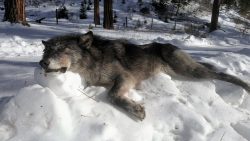Wolf trappers in Montana are a relatively new breed because wolf trapping opportunities in Montana have only been available for a few years. But as trappers hone their skills things keep getting more difficult.
The first year of wolf trapping (2013) in Montana trappers were able to use traditional coyote style methods with big dirt holes, gland lures and baits with success. But it seems that the methods that work on wolves are changing – I first noticed it last year when wolves approached set locations more cautiously than the first year I tried my hand at it. After an entire 2015-2016 season I came up empty on wolves.
Other top trappers began to make mention of the same things happening on their trap lines and the topic has now become fairly routine. Wolves just aren’t as likely to come into a set location that uses a “loud” gland lure or call lure. And certain baits that once worked great seem to be less and less effective with each passing season. Even urine post sets made by trappers are falling short. So what to do?
One thing that will work and isn’t likely to quit working any time soon – is a “blind set” made by observing travel routes and blending a trap where a wolf is going to step on its next walk through the area. This is almost fool proof as long as the trapper doesn’t change anything about the location including leaving too much scent behind.

This 92 pound female wolf was taken by setting a trap where wolves had urinated. No scent or additions were made.
Another rock-solid set that will work is to find a urine post made by wolves and bedding a trap where the wolf will step. Trappers who are trapping in areas of Montana where the wolf population is unpressured will continue to enjoy success with traditional methods for a while so if it works keep using it. Based on my own experience and the stories from other trappers in the areas I trap it seems like successful wolf trapping is becoming more about finding the wolves and setting traps where they already go and less about drawing them into a set location.

This wolf was taken in a blind set made along a natural travel route. Interestingly a wolf urinated near the trap after the blind set was made and this 100 pound male wolf was caught by a hind paw.
Wolf trapping is still relatively new and as we continue to learn so do the wolves. This season I’ve studied the tracks in snow where wolves avoided my traditional sets made with gland lures and baits but walked right into sets made where wolf tracks repeatedly appeared.
This doesn’t mean that in other areas with different wolf packs that traditional sets won’t keep working but it does mean that trappers must keep changing tactics until we find what works in the areas we trap. Studying wolves and wolf behavior and using what we’ve learned is the key to wolf trapping success.
If you are trying to trap wolves, try setting traps without any commercial lures, urines or baits. It has worked for frustrated wolf trappers (including me) and it might be just what you need to connect.
[ Photo Credit: Feature Photo by John MacGillivray]